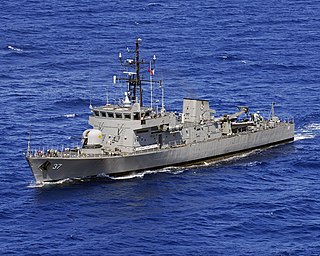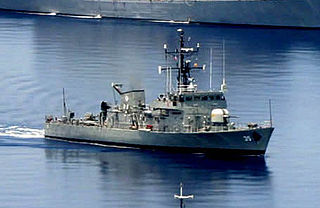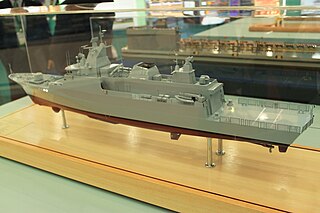
The Royal Malaysian Navy is the naval arm of the Malaysian Armed Forces. RMN is the main agency responsible for the country's maritime surveillance and defense operations. RMN's area of operation consists of 603,210 square kilometers covering the country's coastal areas and Exclusive Economic Zones (EEZ). RMN also bears the responsibility of controlling the country's main Sea Lines of Communications (SLOC) such as the Straits of Malacca and the Straits of Singapore and also monitors national interests in areas with overlapping claims such as in Spratly.

The Floréal class is a type of light "surveillance frigates" designed for the needs of the French Navy in low-threat environments ordered in 1989. The ships are named after months of the Republican Calendar. They use construction standards of commercial ships. The frigates were built between 1990 and 1993 by the Chantiers de l'Atlantique at Saint-Nazaire, France. The six French ships of the class, Floréal, Prairial, Nivôse, Ventôse, Vendémiaire and Germinal, remain in active service.

A stealth ship is a ship that employs stealth technology construction techniques in an effort to make it harder to detect by one or more of radar, visual, sonar, and infrared methods.

Newport-class tank landing ships were an improved class of tank landing ship (LST) designed for and employed by the United States Navy from 1969 to 2002. The ships were intended to provide substantial advantages over their World War II-era predecessors. Larger and faster than any previous LST design, they carried a ramp over the bow that allowed them to surpass 20 knots, a goal of the United States amphibious forces. 27 were planned of which twenty were completed, the high number due to the demands of US force projection estimates. However, the arrival of the air-cushioned landing craft which allowed for over-the-horizon attacks made the class obsolete in the eyes of the United States Navy. Placed in reserve, twelve were eventually sold to foreign navies, while the remaining eight have since been decommissioned.

The Kedah-class offshore patrol vessels of the Royal Malaysian Navy (RMN) are six ships based on the MEKO 100 design by Blohm + Voss. Originally, a total of 27 ships were planned, but due to programme delays and overruns, only six were eventually ordered. Their construction began in the early 2000s, and by 2009, all six were in active service. The six vessels are named after Malaysian states.

BRP Artemio Ricarte (PS-37) is third ship of the Jacinto-class corvettes currently assigned to the Offshore Combat Force of the Philippine Fleet. She is one of few ships in the Philippine Navy equipped with modern systems after the completion of combat, navigation and weapon systems upgrade of her class in August 2019. She was originally called HMS Starling (P241) during her service with the Royal Navy.

The Durango class is an offshore patrol vessel class in service with the Mexican Navy. The Durango class, comprising four ships, was designed and constructed in Mexico in 1999–2000. The class entered service in 2000 and is used primarily for drug interdiction and patrol.

The Sierra-class corvettes are corvettes of the Mexican Navy intended mainly for interception of drug smugglers, exclusive economic zone (EEZ) patrol, and countering terrorism. The class comprises four ships with the lead ship ARM Sierra commissioned by the Mexican Navy in 1998. One ship, ARM Benito Juárez, was sunk as a target ship in 2007 after being wrecked by fire in 2003. The other three vessels remain in service.

ARM Romero, also referred to as ARM Matias Romero, is a Sierra-class offshore patrol vessel of the Mexican Navy. The ship was constructed at Salina Cruz Shipyard in Salina Cruz, Oaxaca, with Romero being launched on 17 September 1999 and entering service the same day.

The BRP Emilio Jacinto (PS-35) is the lead ship of the Jacinto-class corvettes currently assigned to the Offshore Combat Force of the Philippine Fleet. She is one of few ships in the Philippine Navy equipped with modern systems after the completion of combat, navigation and weapon systems upgrade of her class in August 2019. She was originally called HMS Peacock (P239) during her service with the Royal Navy.

The Khamronsin-class corvettes are three corvettes constructed for the Royal Thai Navy in the late 1980s. Based on a British design, all three ships were built in Thailand. A fourth vessel, constructed to a modified design, was built for the Thai Police and was the first to enter service in 1992. The three Khamrosin-class corvettes commissioned in 1992 and remain in service.

The Ratanakosin-class corvettes are a class of two corvettes that were built for the Royal Thai Navy in the 1980s. Constructed by Tacoma Boatbuilding Company in the United States, a third was planned to be built in Thailand but was canceled before construction could begin. The Ratanakosin class is used as flagships for squadrons of fast attack craft.

Hassan II (612) is a Floréal-class frigate of the Royal Moroccan Navy. The ship was the first to be constructed for Morocco by Chantiers de l'Atlantique at Saint-Nazaire, France, from 1999 to 2002. The frigate entered service in 2002. Hassan II is the second of two Floréal-class frigates in Moroccan service, the other being Mohammed V.

KD Kedah (F171) is the lead ship of Kedah-class offshore patrol vessel of the Royal Malaysian Navy. She was commissioned on 5 June 2006.

KD Pahang (F172) is the second ship of Kedah-class offshore patrol vessel of the Royal Malaysian Navy. She was commissioned on 3 August 2006.

KD Terengganu (F174) is the fourth ship of Kedah-class offshore patrol vessel of the Royal Malaysian Navy. She was commissioned on 8 December 2009.

KD Kelantan (F175) is the fifth ship of Kedah-class offshore patrol vessel of the Royal Malaysian Navy. She was commissioned on 8 May 2010.

KD Selangor (F176) is the sixth ship of Kedah-class offshore patrol vessel of the Royal Malaysian Navy. She was commissioned on 28 December 2010.

KD Kasturi is the lead ship of Kasturi-class corvette of the Royal Malaysian Navy (RMN). She was acquired in the 1980s and served under 22nd Corvette Squadron of RMN and based in Lumut Perak. Kasturi is based on HDW's FS 1500 design.

















